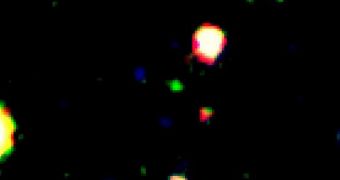In a paper published in the June 1 issue of the esteemed Astrophysical Journal Letters, astronomers detail the discovery of an extremely dim, faraway galaxy called LAEJ095950.99+021219.1. Light emitted by the object took around 13 billion years to reach Earth.
Experts currently estimate that the object developed just 800 million years or so after the Big Bang rapidly expanded the Universe into being. This makes it one of the first galaxies to develop from the hydrogen clouds that existed at the time.
In all likelihood, it is one of the first cosmic structures to appear. According to observations made thus far, it is definitely one of the 10 most distant objects ever discovered. In the image to the left, it is marked by a small green smudge near the center of the photo.
At this point, there is no way of knowing what the once small galaxy looks like, since it appeared to us as it was all those eons ago. It is very likely that it grew significantly since then, and that it is now an extremely old and red, giant elliptical galaxy, possibly the core of a supercluster.
The distant object was discovered using the Inamori-Magellan Areal Camera and Spectrograph (IMACS) instrument on the Magellan Telescopes, which are located at the Chile-based Las Campanas Observatory, a facility operated by the Carnegie Institution.
“This image is like a baby picture of this galaxy, taken when the Universe was only 5 percent of its current age. Studying these very early galaxies is important because it helps us understand how galaxies form and grow,” Arizona State University (ASU) astronomer James Rhoads explains.
The research team that conducted the new observations used a special IMACS filter, which enabled them to block out most wavelengths, except those released by the most distant, faint objects in the Universe. The narrow range of accepted wavelengths was in the infrared portion of the spectrum.
“We have been using this technique since 1998 and pushing it to ever-greater distances and sensitivities in our search for the first galaxies at the edge of the universe,” ASU expert Sangeeta Malhotra says, quoted by Space.
Experts say that LAEJ095950.99+021219.1 has a redshift of 7. Redshift is a value that helps astronomers measure distances, and it refers to the amount of light that has shifted to redder portions of the electromagnetic spectrum, depending on the distance they traveled.
“Up to now, the redshift 7 galaxies we know about are literally the top one percent of galaxies. What we're doing here is to start examining some of the fainter ones – thing that may better represent the other 99 percent,” Malhotra concludes.

 14 DAY TRIAL //
14 DAY TRIAL //